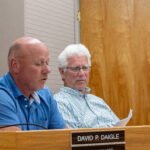Large County wind farm proposal sees delays
Despite the termination of an electricity purchase agreement, the Number Nine Wind Farm proposed for the unorganized territory of central Aroostook County is still on track, according to the company behind the project.
“We are still pursuing Number 9. It is one of the best most mature energy projects in New England,” said Katie Chapman, project manager with EDP Renewables. While the estimated 119 turbine project was originally slated to come online by 2017, Chapman said the company is working towards a goal of completion by 2020 after several setbacks.
EDP Renewables’ power purchase agreement with two Connecticut utilities, signed in 2013 to line up customers for some of power from the project, was terminated in July, due to a number of delays, Chapman said.
The power purchase agreements with Connecticut utilities Eversource Energy and United Illuminating Company were terminated “once it became clear that we would not meet the project schedule milestones due to extraordinary delays in the interconnection process, the technical process for connecting to the grid.”
Chapman said the company has been waiting for three years for a study of the connection to the grid from ISO New England, the organization that runs the grid for New England’s six states but not for northern Maine, which has its own grid connected to New Brunswick. Exporting power from the Number Nine wind project would require connecting to the ISO New England grid via a new transmission line between Haynesville and Houlton.
Marcia Blomberg, a spokesperson for ISO New England, said in an email that “ISO has worked diligently and in a timely fashion with EDP to conduct the required engineering studies to identify what is required to interconnect their project without having an adverse impact.” She added that the transmission connections would be in areas that “were not designed or constructed to carry large amounts of electricity.”
The discontinuation of the purchase agreements left EDP on the hook for almost $5 million in termination payments to the two utilities. “It is important to note that the past, present, and future costs for the project thus far are entirely EDP’s and have not been passed and will not be passed to ratepayers or utilities,” Chapman noted.
Going forward, EDP is optimistic about finding long-term, out-of-state buyers of electricity for Number Nine and potentially other wind projects in Aroostook County, she said.
EDP, along with a number of other renewable energy developers, are waiting to hear whether their projects were selected by the New England Clean Energy RFP, a joint effort by state governments and utilities in Connecticut, Massachusetts and Rhode Island to procure long-term renewable energy supplies for their residents.
EDP proposed supplying the states with between 250 and 600 megawatts of electricity, and if selected for more than 250 megawatts the company could develop another wind farm beyond Number Nine, Chapman said.
Proposals from New England Clean Energy RFP were supposed to have been selected by late July, but that process has been extended and there have been no decisions yet. “If not selected” for the RFP, “we would seek another buyer,” Chapman said.
Meanwhile, the Number Nine project’s application with the Maine Department of Environmental Protection is on administrative hold, and could either be amended or refiled as a new application depending on the results of the New England RFP, Chapman said.
“If we’re selected for 250 megawatts, there’s not a lot of work to reammend,” Chapman said. “If we’re selected for 600 megawatts, that would be a significant change and we would likely submit a new application.”
Chris O’Neil, director of public policy for Friends of Maine’s Mountains, a group opposed to the Number Nine and other wind farms, said that the delays in the wind project may not derail the project, but that they suggest some concern among utilities about wind projects dependent on grid changes. O’Neil added that EDP also has to resolve a number of environmental issues in its application, including concerns about potential impacts to bats that were raised by the Maine Department of Inland Fisheries and Wildlife in their comments with the DEP.
Chapman said the company is working on resolving a number of those issues, including the question of “curtailment,” the wind speed threshold for when turbines can start spinning that’s set in order to avoid harming bats, which fly at low-wind speeds. IFW has suggested a curtailment speed of 6.5 meters per second (the equivalent of 14.5 miles per hour), while the company’s wind farms across the country generally have a curtailment of 5.5 meters per second, Chapman said.







